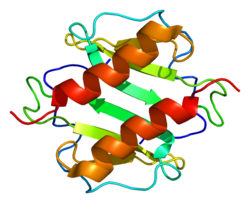A NOVEL APPROACH,
The CRBCM is not claiming here to create anything new, Anti-Notch or Notch inhibitor are available and as reported have been used to no avail in Pancreatic cancer. But scientists are getting smarter by dissecting and discerning better various mechanisms of actions of drugs and pathogenesis of disease. And as you embark in this exercise, let me bring to your mind 2 interesting observations.
1. IL-2
This Cytokine attract White cell of the LYMPHOCYTE kind to the tumor
and sure enough kill Melanoma cells and Renal cancer cell.
wikipedia:
"Interleukin 2 (IL-2) is an interleukin, a type of cytokine signaling molecule in the immune system. It is a protein that regulates the activities of white blood cells (leukocytes, often lymphocytes) that are responsible for immunity."
2.Melanoma cells have a growth factor,
don't take my word but always trust wikipedia
"
CXCL1
From Wikipedia, the free encyclopedia
| Chemokine (C-X-C motif) ligand 1 (melanoma growth stimulating activity, alpha) | |||||||||||
|---|---|---|---|---|---|---|---|---|---|---|---|
 PDB rendering based on 1mgs. |
|||||||||||
|
|||||||||||
| Identifiers | |||||||||||
| Symbols | CXCL1; FSP; GRO1; GROa; MGSA; MGSA-a; NAP-3; SCYB1 | ||||||||||
| External IDs | OMIM: 155730 MGI: 3037818 HomoloGene: 117693 GeneCards: CXCL1 Gene | ||||||||||
|
|||||||||||
| Orthologs | |||||||||||
| Species | Human | Mouse | |||||||||
| Entrez | 2919 | 330122 | |||||||||
| Ensembl | ENSG00000163739 | ENSMUSG00000029379 | |||||||||
| UniProt | P09341 | Q6W5C0 | |||||||||
| RefSeq (mRNA) | NM_001511 | NM_203320 | |||||||||
| RefSeq (protein) | NP_001502 | NP_976065 | |||||||||
| Location (UCSC) | Chr 4: 74.74 – 74.74 Mb |
Chr 5: 90.79 – 90.79 Mb |
|||||||||
| PubMed search | [1] | ||||||||||
Function
CXCL1 is secreted by human melanoma cells, has mitogenic properties and is implicated in melanoma pathogenesis.[2][3] CXCL1 is expressed by macrophages, neutrophils and epithelial cells,[4][5] and has neutrophil chemoattractant activity.[6][7] CXCL1 plays a role in spinal cord development by inhibiting the migration of oligodendrocyte precursors and is involved in the processes of angiogenesis, inflammation, wound healing, and tumorigenesis.[8][9][10][11] This chemokine elicits its effects by signaling through the chemokine receptor CXCR2.[8] The gene for CXCL1 is located on human chromosome 4 amongst genes for other CXC chemokines.[12] An initial study in mice showed evidence that CXCL1 decreased the severity of multiple sclerosis and may offer a neuro-protective function.[13]================================================================
Now you have IL-2 lymphocytes
and Melanoma cell growth factor (MSGA-alpha) attracting Neutrophil
and as you dig deeper you will find that alpha is not the only type used by melanoma cell, there is a Beta, and gamma MSGA
but the point is that it attract Neutrophils. Is it to preclude or otherwise impede or shield it self from Lymphocyte attraction? And allows remember you don't grow by attracting enemies! These are friendly Neutrophils shielding the cell from detection! And the Melanoma cell knows what to do for them inherently though its NOTCH system! High dose IL-2 will bring lymphocytes here anyway.! the question is, COULD DISABLING THE NOTCH HERE PRIOR TO IL-2 INFUSION HELP IL-2 EFFECT IN MELANOMA?. COULD ADDING AN ANTI-NOTCH TO GEMZAR-ABRAXANE HELP IN PANCREATIC CANCER? ANTI-NOTCH ALONE ONLY OPEN THE CELL TO VULNERABILITY AND MAY NOT BE A TREATMENT ON ITS OWN WE BELIEVE, UNLESS THE LIFE OF THE CELL IS STRICTLY DEPENDING ON IT...AND ONLY IN BRAIN CELLS AND MYOCARDIUM WHERE ELECTRICITY CONDUCTION AND COORDINATION,SO DEPENDENT ON NOTCH, CAN HAVE THEIR LIFE IMPLICATED DEARLY WITH NOTCH!
We should mention also finishing here that for Melanoma cells, it appears that these Cytokines
help the cell with its immortality (which involves Telomeres and MTOR), growth and tumor formation by anchorage capacity), autocrine function and living in a "stress" mode without too much dependence from outside. they help the cell with chemotaxis (directing metastasis), angiogenesis (to ensure O2 supply and avoid too much stimulation of the Hypoxia induced factor/MTOR) and ensure Growth. Only an epigenetic intervention can curb significantly these autocrine growth factor. and curbing them we must to make a difference! (Look at the point of impact for targeted therapy, at each step, one may intervene!).
CAUTION
disabling the NOTCH may happen in normal cell, and now what? Brace for it!
also read
Notch signaling contributes to lung cancer clonogenic capacity in vitro but may be circumvented in tumorigenesis in vivo.
Osanyingbemi-ObidiAND
No comments:
Post a Comment